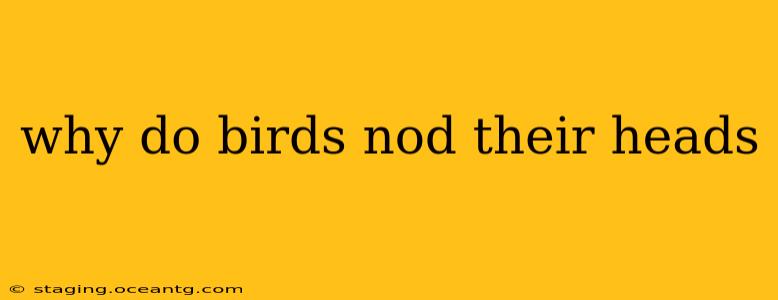Birds' head-bobbing is a common behavior that has fascinated ornithologists and bird enthusiasts alike. While it might seem like a simple, almost inconsequential movement, the reasons behind this avian head-bob are surprisingly complex and multifaceted. It's not a single answer, but rather a combination of factors depending on the species and context. Let's delve into the various possibilities.
Is it to See Better? The Visual Acuity Hypothesis
One prominent theory suggests that birds nod their heads to enhance their visual acuity. This is particularly relevant for birds with forward-facing eyes, like owls, which have a limited field of binocular vision. By bobbing their heads, they shift their visual perspective, creating a stereoscopic image which provides better depth perception and helps them accurately judge distances, crucial for hunting and navigating complex environments.
This is supported by research showing that birds adjust their head-bobbing frequency based on the distance of the object they're observing; faster bobs for closer objects, slower bobs for distant ones. This suggests a deliberate, functional purpose related to visual processing.
Maintaining Balance and Stability: A Kinetic Explanation
Another hypothesis centers on the idea of balance and stability. Birds, especially smaller species, need to constantly adjust their balance to maintain their posture, particularly while foraging or navigating branches. The subtle head movements could be a form of proprioceptive feedback – a subconscious adjustment to maintain equilibrium and prevent falls. Think of it as a tiny, continuous recalibration of their center of gravity.
Communication and Social Signaling
While less established than the visual and kinetic explanations, head-bobbing could also serve as a form of nonverbal communication. Some species exhibit distinctive head-bobbing patterns during courtship displays or territorial disputes. These movements could signal intent, dominance, or readiness to mate. More research is needed to understand the nuances of this communicative aspect in various bird species.
What about different types of head bobs? Are they all the same?
The way a bird bobs its head can differ significantly. It's not just a simple up-and-down motion. The speed, amplitude, and even the direction of the bob can vary, adding layers of complexity to its interpretation. Some bobs are quick and sharp, others are slow and deliberate. The exact meaning remains a topic of ongoing research, requiring meticulous observation and analysis of each species' individual behavior.
Do all birds bob their heads?
No, not all birds bob their heads. The frequency and style of head-bobbing vary greatly between species, influenced by factors like vision, body size, and social behavior. For example, birds of prey, known for their exceptional eyesight, may show different head-bobbing patterns than smaller, more agile species.
Why do some birds seem to bob their heads more than others?
The rate and style of head-bobbing are species-specific. Birds with better binocular vision may bob their heads less frequently, as they don't need to rely as heavily on the technique to enhance depth perception. Conversely, species with less overlap in their fields of vision might bob more often to obtain the necessary stereoscopic vision. Additionally, certain environmental factors or individual variations can also influence how frequently a bird bobs its head.
Conclusion: A Multifaceted Behavior
In conclusion, the reason why birds nod their heads is likely a multifaceted behavior with visual acuity, balance, and communication all playing potential roles. The specific reasons can differ based on the species, context, and individual bird. Further research is continually unveiling new insights into this intriguing avian behavior. By combining observations with technological advancements, we're getting closer to a complete understanding of this fascinating aspect of bird life.
